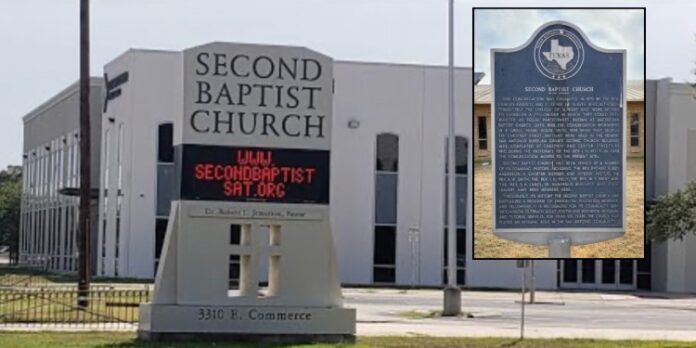An Eastside Historic Church
Before October of 1890, Second Baptist Church was named Macedonia Second Baptist Church. According to the Churches current Website, in July of 1879, twelve dedicated Christian men and women met in worship at a location on Indiana and Goliad Streets in the Fourth Ward with Reverend Charles Augustis. The founders of the East Side Macedonia 2nd Baptist Church included Reverend Reuben Anderson, Mrs. Elvina Anderson, Mrs. Anna Hill, Mrs. Alice Lewis, Mrs. L. M. Logan, Mrs. Dadie Grallam, Mrs. Laura Franklin, Mr. H. T. Harvey, Mr. Benjamin Jones, Mr. Jessie Riddle, Mr. Jesse Winn and Mr. Alexander Hogan. These members sought to create a place of worship with the full knowledge of the historical importance of the Black church as a place of survival and resistance during the Jim Crow era.
Several sites have served as locations for the church. Live Oak and Dawson Streets was of the sites for the church and in 1894 a church was constructed on the corner of Chestnut and Center Streets in was what then possibly known as the Third Ward. Interestingly, Sanborn Maps indicate that a “Colored Baptist Church” was already at that location in 1892. The political ward system in 1880 would be composed of four wards but would change as time went on eventually developing into eight wards by the early 1900s. In 1903, an effort to rebuild the church was made that would include a rectory. From 1909-1910, under the leadership of the pastor, Reverend Isaiah Kelly, a stone church was erected at the Chestnut and Center Street site. The location of the church was in the heart of the Black community in the St. Paul Square area. Historically, 1909 was the birth date of the NAACP, and for a period of time San Antonio would eventually have one of the largest memberships despite local KKK opposition to the organization meeting in Black churches.
Interestingly, According to Robert V. Haynes in his book, A Night of Violence; The Houston Riot of 1917, the Reverend Isaiah Kelly of Macedonia Second Baptist Church, now Second Baptist Church, said the last prayers before the Black soldiers who were unjustly hanged at Fort Sam Houston on the Salado Creek in 1917 as a result of the Houston, Texas “riot” in which Black soldiers stepped up to protect a Black woman being abused by Houston police officers. According to Kenneth Mason’s research, Reverend Kelly would later associate himself with the San Antonio Ku Klux Klan Chapter 31 by accepting funds to improve the edifice at the church. Also, Pastor Kelley associated himself with a white supremacist organization called “The Star of Columbia,” a front organization that was used to provide cover for the Klan and buy off Black ministers with money and jobs.
In the San Antonio Public Library are the records of that newspapers and the front page of the San Antonio American Forum newspaper, the paper of the local KKK, they announced that they were providing donations to improve the edifice of Second Baptist Church. This compromised Reverend Kelley, and other Black ministers, who were pressured into preventing the local NAACP meeting space in Black Baptist churches. Reverend Kelly, in following the dictates of the Klan, went so far as to denounce the NAACP. Rev Kelly would eventually be removed from the church in a violent confrontation with church members. According to the November 1933 issue of the San Antonio Register Kelly was the pastor from 1904 until 1933, but Kelly’s disgraceful behavior and opposition to the NAACP led to his removal from the church.






